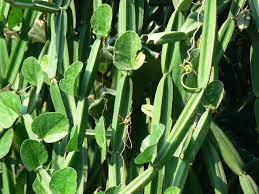Pirandai (Cissus quadrangularis)
Introduction
Pirandai, scientifically known as Cissus quadrangularis,
is a traditional medicinal plant that has been used for centuries in various
indigenous systems of medicine. Its popularity stems from its reputed
therapeutic properties, especially in treating bone fractures, joint disorders,
and digestive ailments. This article delves into the scientific aspects of
Pirandai, exploring its chemical constituents, pharmacological activities, and
potential applications in modern medicine.
Botanical Description and Distribution
Pirandai belongs to the Vitaceae family and is a perennial
climber with succulent quadrangular stems. It is primarily found in tropical
regions of India, Sri Lanka, and parts of Africa. The plant possesses green,
fleshy leaves with an oblong shape and small yellowish flowers. The stems are
known for their characteristic nodes and internodes, making them easily
recognizable.
Chemical Constituents
Scientific investigations have revealed that Pirandai
contains a diverse range of bioactive compounds. These include triterpenoids
(such as asiaticoside and asiatic acid), flavonoids, carotenoids, sterols, and
various minerals. Triterpenoids, particularly the asiaticoside present in
Pirandai, have attracted significant attention due to their potential
pharmacological activities.
Pharmacological Activities
Pirandai has demonstrated a plethora of pharmacological
activities through numerous studies. The plant possesses analgesic,
anti-inflammatory, antioxidant, antimicrobial, antidiabetic, and
hepatoprotective properties. These activities can be attributed to the presence
of triterpenoids, flavonoids, and other bioactive compounds. Pirandai's ability
to enhance fracture healing and stimulate bone formation has been extensively
studied, highlighting its potential as a natural alternative for bone health
management.
Bone Health Benefits
Pirandai has been traditionally used in Ayurveda and Siddha
medicine systems for promoting bone health and treating bone-related disorders.
Research suggests that Pirandai stimulates the activity of osteoblasts (cells
responsible for bone formation) while inhibiting osteoclasts (cells involved in
bone resorption). These effects contribute to accelerated fracture healing,
increased bone mineral density, and improved bone strength.
Digestive Health Benefits
The traditional use of Pirandai in digestive disorders finds
support in scientific studies. Pirandai possesses gastroprotective properties,
protecting the stomach lining from ulcer formation. It also exhibits laxative
effects, aiding in constipation relief. Additionally, Pirandai has shown
anti-inflammatory effects on the gastrointestinal tract, making it a potential
therapeutic agent for inflammatory bowel diseases.
Other Potential Applications
Preliminary research suggests that Pirandai may have several
other applications. Its antimicrobial properties make it a promising candidate
for combating bacterial and fungal infections. Moreover, the plant's
antioxidant and antidiabetic activities may contribute to its role in managing
oxidative stress and diabetes.
Safety Considerations
While Pirandai shows immense potential as a medicinal plant,
it is essential to consider safety precautions. Some studies have reported mild
gastrointestinal discomfort and allergic reactions as potential adverse
effects. Pregnant and breastfeeding women, as well as individuals with
pre-existing medical conditions, should consult a healthcare professional
before using Pirandai.
Conclusion
Pirandai (Cissus quadrangularis) is a traditional
medicinal plant with a rich scientific heritage. Its diverse range of bioactive
compounds and pharmacological activities demonstrate its potential in modern
medicine. Further research is required to explore Pirandai's full therapeutic
potential, elucidate its mechanisms of action, and determine optimal dosage and
formulations for different applications. Clinical trials are needed to validate
its efficacy and safety in human subjects. Additionally, efforts should be made
to ensure sustainable cultivation and conservation practices to meet the
growing demand for Pirandai.
In conclusion, Pirandai (Cissus quadrangularis) is a
traditional medicinal plant with significant scientific potential. Its
bioactive compounds, pharmacological activities, and traditional uses support
its exploration as a valuable resource in modern medicine. From bone health
benefits to digestive health properties, Pirandai shows promise in various
therapeutic applications. However, further research and clinical trials are
necessary to establish its efficacy, safety, and dosage guidelines. With
continued scientific exploration and responsible utilization, Pirandai may
contribute to the development of novel natural remedies for numerous health
conditions.
HAPPY
BLOGGING!!!
DEEPIKA
KRISHNAMOORTHY
A
RESEARCH SCHOLAR



Comments
Post a Comment